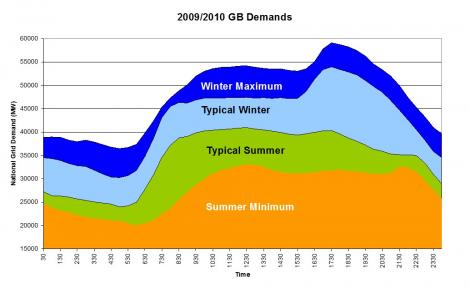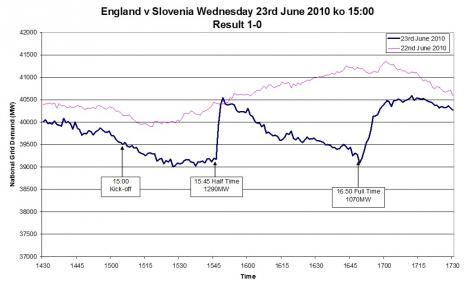Generating the Electricity
The UK can generate a maximum of 60 GW (60,000,000,000watts) with all the power stations operating a full power and all the wind and solar farms generating..
National Grid has to match our demand for electricity by increasing or decreasing output from the power stations on a minute by minute basis.
There’s no effective way to generate excess electricity and store it at the moment. The idea of huge batteries storing electricity generated and not used is tempting but not easy - Elon Musk's battery system in Australia can supply enough for 30,000 houses but only for half an hour!

Typical electricity demand profiles
Typically the Uk's lowest electricity demand level is about 40 GW (Gigawatts), (overnight in the summer) and the highest is about 60 GW (on the coldest, dark night in the winter).

World Cup 2010 National Grid Demand
Variations in our electricity use can be quite notable, particularly if there is a very popular programme on the television. Controlling the amount of electricity generated to match our demand takes a great deal of technology – it’s a 24/7 job!
* Images courtesy of National Grid
So how much electricity does each person use - on average?
The UK's maximum demand for electricity on a cold, dark night:
~ 60GW 6 x 1010 W
Let's assume the UK population:
~ 60 Million 6 x 107 person
To find the electricity use per person we divide
(6 x 1010 / 6 x 107) watts per person
~ peak use per person = 1 x 103 W
Peak average electricity usage is about 1 kW electricity per person in the UK,
So on a cold, dark winter’s night the UK uses about 1 kW electricity per person – and this is the maximum that the UK can generate with all the power stations turned up full.
This is used not only in our homes, but in shops, hospitals, offices, factories, road lighting, traffic lights etc etc.
Delivering electricity to your home
The earlier calculation showed that the peak, average use per person: ~1 kW electricity
National Grid estimates that the typical peak household demand: ~10 kW
(This relies upon the local electrical system to deliver the electricity to all the houses in the street)
Let's assume there are 10 houses in your street
So the average peak demand for your street : ~100 kW
(the local electrical system is designed to provide ~100 kW to your street)
So this is why EV's can be a problem...
Imagine that your neighbours buy electric cars and plug them in to charge overnight - which is the preferred time to recharge!
Let's assume your neighbours have slow charging cars then each car will take 8 kW to charge.
(Let's hope your neighbours don't buy 150 kW 'fast charging' cars - things get a lot worse if they do!)
Let's assume 5 of your neighbours in your street buy electric cars, then the extra peak electricity demand due to cars: ~40 kW
Potentially the total electricity required for the street: ~ 100 + 40 = 140 kW
This is a 40% increase – the local electricity system can’t take it!
The National Grid is 50 years old but was only built to last 40 year.
The Grid was installed at a time when houses had very few electrical gadgets and isn't very robust any more.

It gets worse….
From before we found out that the UK electrical generation systems can generate a maximum of : ~60 GW (60 gigawatts or 60,000,000,000 watts)
We know there are 32 million cars in UK
Let's assume just 1/3rd (10 million) car owners decide to recharge overnight - the most popular time.
If each car needs 8 kW (so not the fast charging 150 kW cars)
Potentially the extra electricity demand from cars recharging across the UK overnight is: ~80 GW
The UK can’t generate enough electricity to charge the cars.
Plus the electricity grid isn't robust enough to distribute the power required to charge even slow charging cars.
If many people buy fast charging cars it gets worse. Fast charging takes such high currents it's very likely that the transformers in local substations will fail and we will get power cuts!
It possibly could work if we turn our houses off!